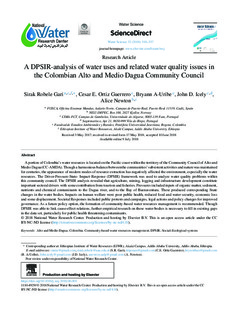| dc.contributor.author | Gari, Sirak Robele | |
| dc.contributor.author | Guerrero, Cesar E. Ortiz | |
| dc.contributor.author | A-Uribe, Bryann | |
| dc.contributor.author | Icely, John D. | |
| dc.contributor.author | Newton, Alice | |
| dc.date.accessioned | 2018-11-22T11:01:59Z | |
| dc.date.available | 2018-11-22T11:01:59Z | |
| dc.date.created | 2018-08-03T11:34:19Z | |
| dc.date.issued | 2018 | |
| dc.identifier.citation | Water Science : The National Water Research Center Journal. 2018, 32 318-337. | nb_NO |
| dc.identifier.issn | 1110-4929 | |
| dc.identifier.uri | http://hdl.handle.net/11250/2574350 | |
| dc.description.abstract | A portion of Colombia’s water resources is located on the Pacific coast within the territory of the Community Council of Alto and Medio Dagua (CC-AMDA). Though a harmonious balance between the communities’ subsistent activities and nature was maintained for centuries, the appearance of modern modes of resource extraction has negatively affected the environment, especially the water resources. The Driver-Pressure-State- Impact-Response (DPSIR) framework was used to analyze water quality problems within this community council. The DPSIR analysis revealed that agriculture, mining, logging and infrastructure development constitute important sectoral drivers with some contribution from tourism and fisheries. Pressures included inputs of organic matter, sediment, nutrients and chemical contaminants to the Dagua river, and to the Bay of Buenaventura. These produced corresponding State changes in the water bodies. Impacts on human welfare were poor public health, reduced food and water security, economic loss and some displacement. Societal Responses included public protests and campaigns, legal actions and policy changes for improved governance. As a future policy option, the formation of community-based water resources management is recommended. Though DPSIR was able to link cause-effect relations, further empirical research on these water bodies is necessary to fill in existing gaps in the data set, particularly for public health threatening contaminants. | nb_NO |
| dc.language.iso | eng | nb_NO |
| dc.rights | Attribution-NonCommercial-NoDerivatives 4.0 Internasjonal | * |
| dc.rights.uri | http://creativecommons.org/licenses/by-nc-nd/4.0/deed.no | * |
| dc.title | A DPSIR-analysis of water uses and related water quality issues in the Colombian Alto and Medio Dagua Community Council | nb_NO |
| dc.title.alternative | A DPSIR-analysis of water uses and related water quality issues in the Colombian Alto and Medio Dagua Community Council | nb_NO |
| dc.type | Journal article | nb_NO |
| dc.type | Peer reviewed | nb_NO |
| dc.description.version | publishedVersion | nb_NO |
| dc.rights.holder | © 2018 National Water Research Center. Production and hosting by Elsevier B.V. | nb_NO |
| dc.source.pagenumber | 318-337 | nb_NO |
| dc.source.volume | 32 | nb_NO |
| dc.source.journal | Water Science : The National Water Research Center Journal | nb_NO |
| dc.identifier.doi | 10.1016/j.wsj.2018.06.001 | |
| dc.identifier.cristin | 1599612 | |
| dc.relation.project | EC/FP7/282845 | nb_NO |
| dc.relation.project | NILU: 112023 | nb_NO |
| cristin.unitcode | 7460,55,0,0 | |
| cristin.unitname | Miljøeffekter og bærekraft | |
| cristin.ispublished | true | |
| cristin.fulltext | original | |
| cristin.qualitycode | 1 | |

